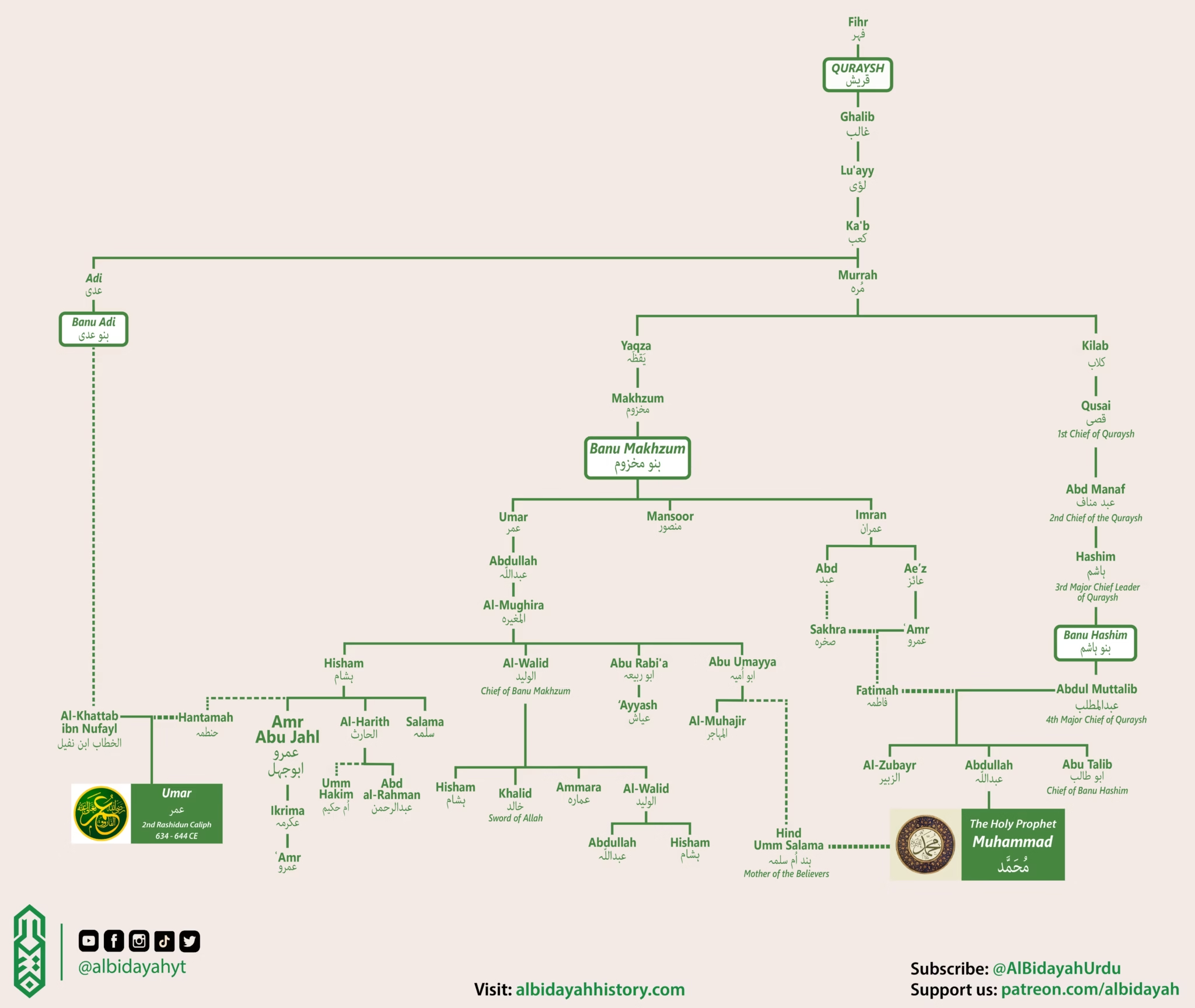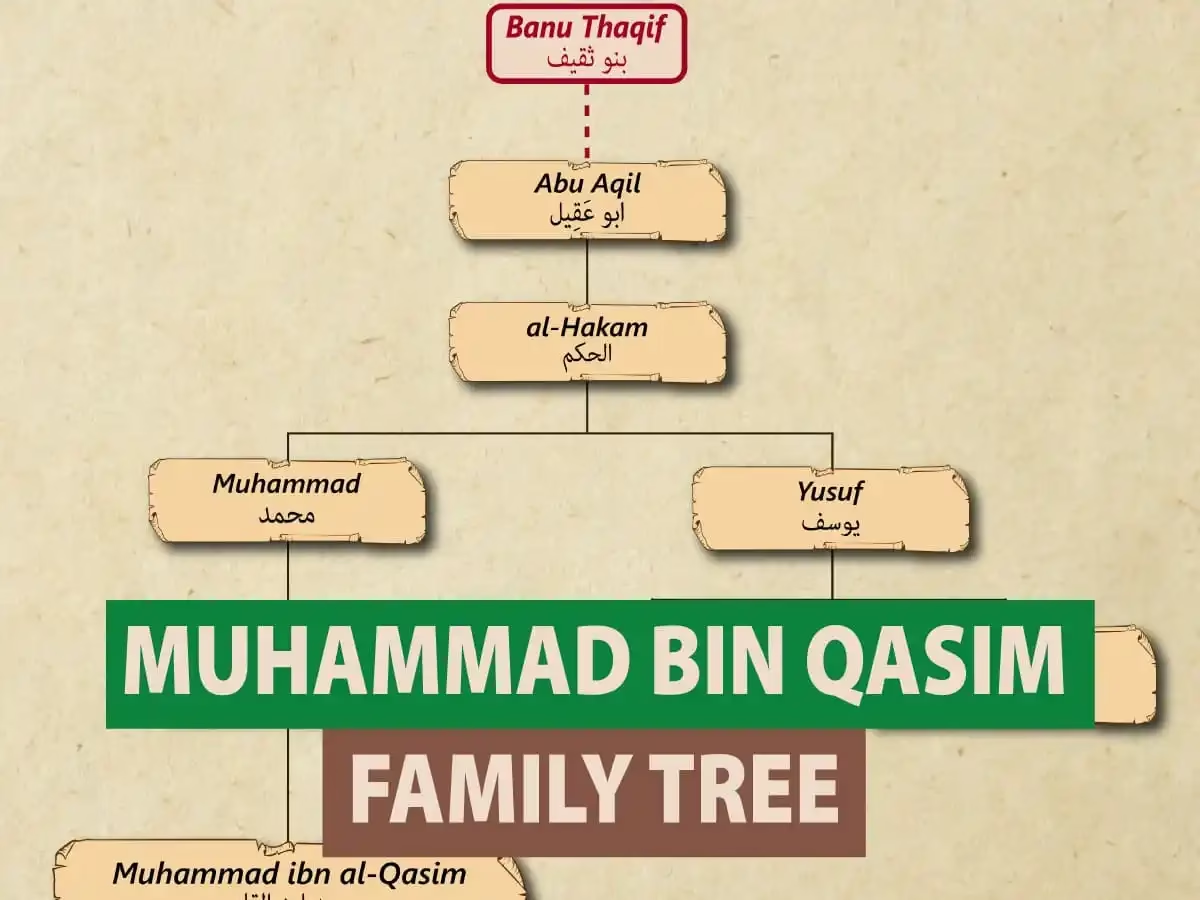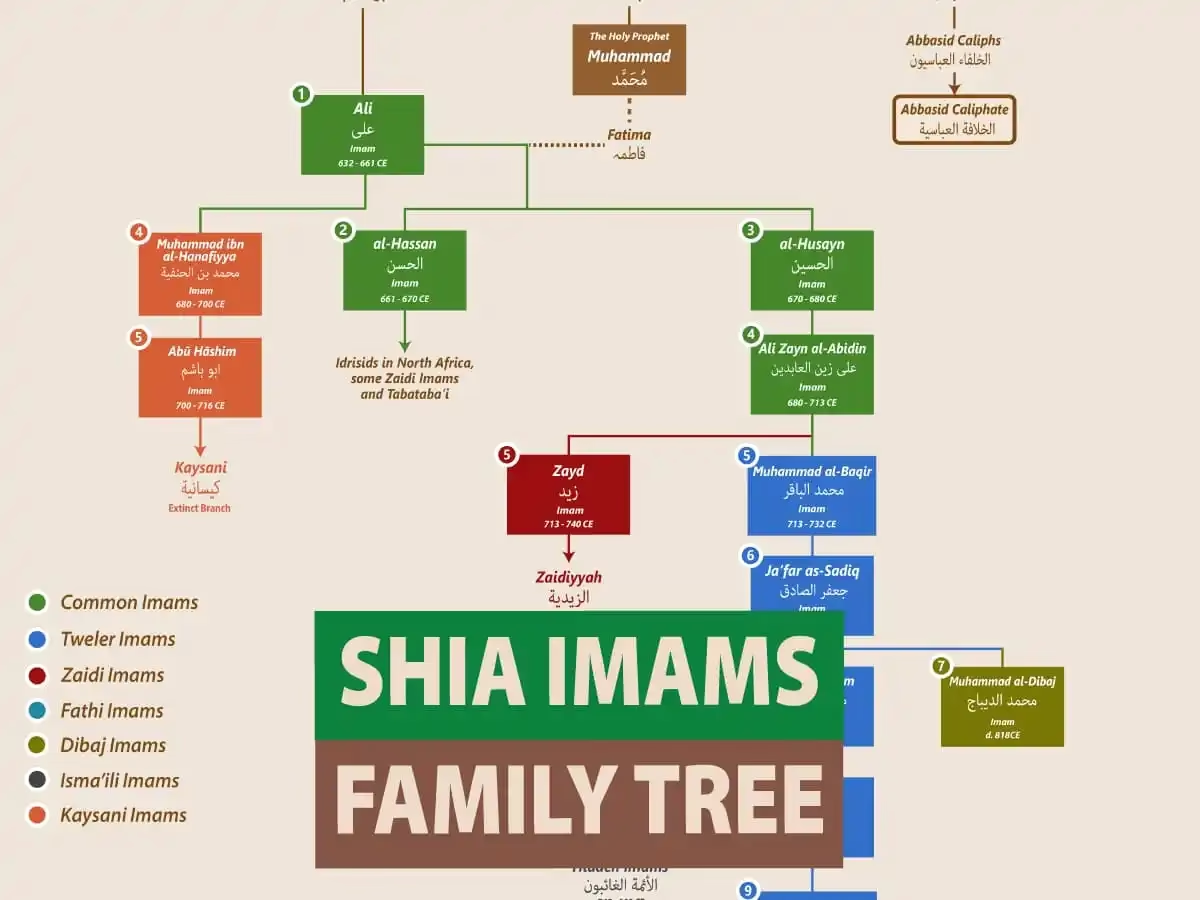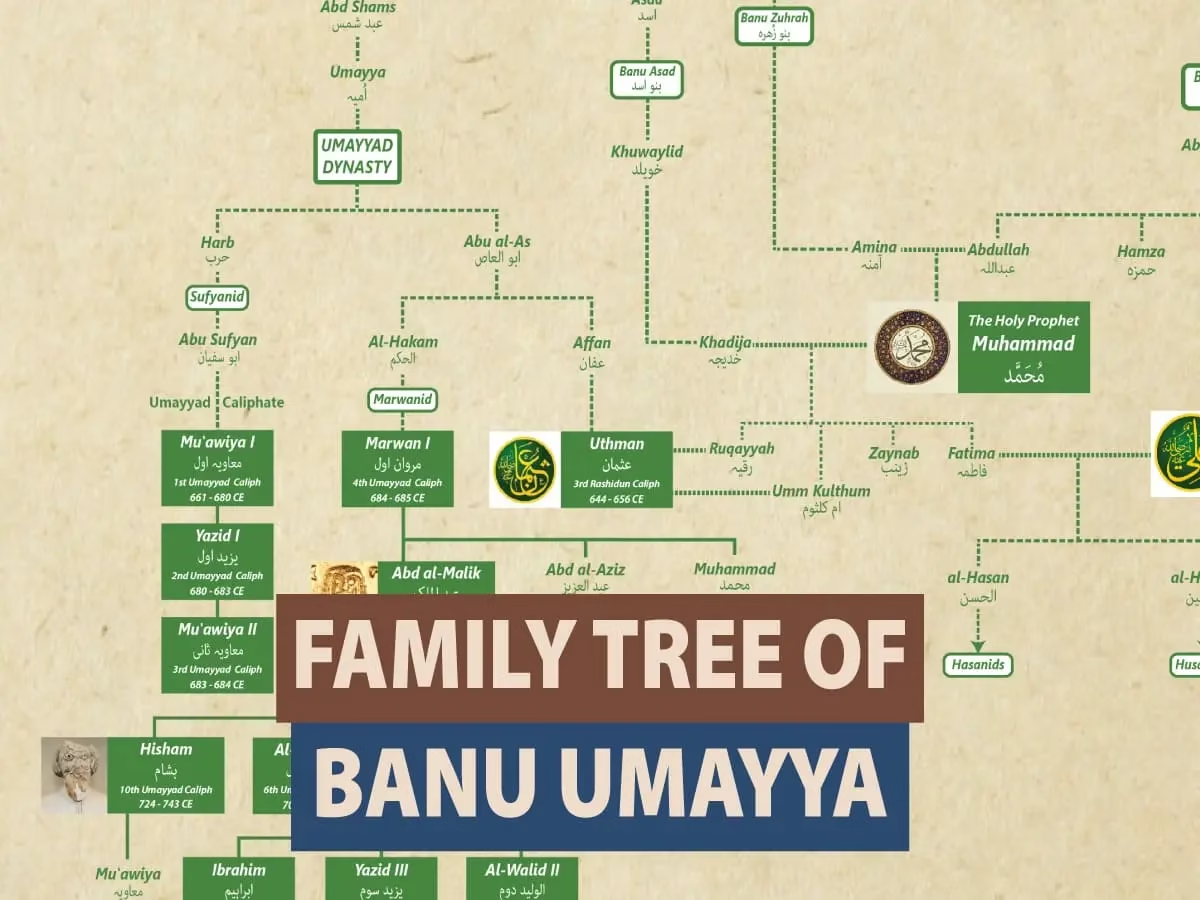The family tree of Amr ibn Hisham, better known as Abu Jahl, highlights his lineage and connections to key figures in Islamic history. Abu Jahl descends from the noble Quraysh tribe, tracing back to Fihr ibn Malik, through notable ancestors such as Ghalib, Lu’ay, Ka’b, Murrah, and Yaqza, leading to Makhzum, the eponymous ancestor of the Banu Makhzum clan.
Origins of Banu Makhzum
The Banu Makhzum traced their lineage to Makhzum, the son of Yaqza. This clan was part of the Quraysh tribe, descended from Fihr, an ancestor of the Prophet Muhammad (peace be upon him). Positioned among the elite tribes of Mecca, the Banu Makhzum were renowned for their military prowess, wealth, and leadership abilities.

Makhzum (Founding Ancestor)
Makhzum, the progenitor of the clan, set the foundation for a powerful lineage. His descendants included warriors, leaders, and influential figures who played critical roles in Meccan society.
See Also: Banu Mukhzum Family Tree
Al-Mughirah
Al-Mughirah was a key figure in the clan’s history and served as the chief of Banu Makhzum. He was revered for his leadership, wealth, and political influence, which helped the clan maintain its high status in Mecca.
Abu Jahl (Amr ibn Hisham)
Abu Jahl, whose real name was Amr ibn Hisham, was a powerful leader of the Quraysh tribe in Mecca. He was a strong opponent of Prophet Muhammad (PBUH) and worked hard to stop the spread of Islam. Before Islam, he was respected and called “Abu al-Hakam” (Father of Wisdom), but because of his harsh treatment of Muslims, Prophet Muhammad (PBUH) called him “Abu Jahl” (Father of Ignorance).
Abu Jahl persecuted early Muslims, including Sumayya and Yasir ibn Amir. After Prophet Muhammad (PBUH) and his followers migrated to Medina, Abu Jahl led an army to fight them. This led to the Battle of Badr on 13 March 624. During the battle, he was wounded by Mu’awwidh and Mu’ādh ibn ‘Amr and later killed by Abdullah ibn Masud. His death marked a major victory for the Muslims.

Abu Jahl’s Connection to Umar ibn Al-Khattab
Another significant connection within this family tree is between Abu Jahl and Umar ibn Al-Khattab, the second caliph of Islam. Umar belonged to the Banu Adi, a sub-clan of the Quraysh, yet his lineage intersects with the Banu Makhzum through his mother, Hantamah bint Hisham, who was Abu Jahl’s sister.
Abu Jahl’s Connection to Al-Walid ibn Al-Mughira
Abu Jahl and Al-Walid ibn Al-Mughira were close relatives from the Banu Makhzum clan of the Quraysh tribe. Their fathers, Hisham and Al-Mughira, were brothers, making Al-Walid, Abu Jahl’s uncle. As influential leaders of the Quraysh, both Al-Walid and Abu Jahl were united in their opposition to the Prophet Muhammad (peace be upon him) and his message.
Abu Jahl’s Children
Ikrima ibn Abi Jahl
Ikrima ibn Abi Jahl was the son of Amr ibn Hisham (Abu Jahl). He played a key role in the Battle of Uhud (625 CE), commanding the left wing of the Quraysh army, while his cousin Khalid ibn al-Walid led the right wing.
As a staunch opponent of Prophet Muhammad (PBUH), Ikrima rejected the Treaty of Hudaybiyyah and later violated it by attacking the Banu Khuza’a. However, after the conquest of Mecca (630 CE), he fled toward Yemen. His wife, Umm Hakim, who had embraced Islam, pleaded for his forgiveness. The Prophet granted him a pardon, and Ikrima accepted Islam sincerely.
Ikrima later became a committed Muslim and fought alongside the early Islamic armies. Under Caliph Abu Bakr, he led campaigns in the Ridda Wars and later joined Khalid ibn al-Walid in the Muslim conquests of Syria. He was martyred in 634 CE at the Battle of Ajnadayn while fighting the Byzantines, marking his complete transformation from an enemy of Islam to one of its greatest warriors.
Abu Jahl’s Siblings
Al-Harith ibn Hisham
Al-Harith ibn Hisham was a member of Banu Makhzum clan. His father, Hisham ibn al-Mughira, was a respected Quraysh leader. Like his brother Abu Jahl, he initially opposed Prophet Muhammad (PBUH) and fought against the Muslims at the Battle of Badr (624) and Battle of Uhud (627).
However, during the conquest of Mecca (630), Al-Harith accepted Islam and later fought in the Battle of Hunayn. He played a key role in the Muslim conquest of Syria, fighting in major battles like Ajnadayn (634), Fahl, and Yarmouk (636), under Khalid ibn al-Walid. After the conquests, Al-Harith moved to Syria with his family. His death is uncertain—some say he died in battle, while others believe he perished in the Plague of Amwas (639), which killed most of his family.
Ayyash ibn Abi Rabi’a
Ayyash ibn Abi Rabi’a was an early convert to Islam and a half-brother of Abu Jahl. To escape persecution, he migrated to Medina with Prophet Muhammad (PBUH).
Abu Jahl, determined to bring him back, tricked Ayyash by claiming their mother was critically ill. Despite Umar ibn Al-Khattab’s warnings, Ayyash returned to Mecca. On the way, Abu Jahl betrayed him, tied him up, and imprisoned him, subjecting him to harsh treatment.
Ayyāsh’s suffering deeply concerned Prophet Muhammad (PBUH). According to Sahih Bukhari (6541), he would often pray:
“O Allah, rescue Ayyāsh ibn Abī Rabīʿa! O Allah, rescue Salama ibn Hisham! O Allah, rescue al-Walid ibn al-Walid! O Allah, rescue all oppressed believers!”
This prayer highlighted the plight of the persecuted Muslims and the urgency of their liberation.
Salma ibn Hisham
Salama ibn Hisham, another early Muslim convert, also faced severe persecution in Mecca. Like Ayyāsh, he endured captivity and remained faithful to Islam despite immense pressure. He later gained freedom and participated in several key battles.
In 636 AD, both Ayyāsh and Salama fought in the historic Battle of Yarmouk. This battle was a decisive victory against the Byzantine Empire. Unfortunately, they both fell as martyrs on the battlefield. They were buried alongside Ikrimah ibn Abi Jahl, Ayyāsh’s nephew. Their sacrifices became a symbol of devotion, resilience, and unwavering faith.
Hantamah bint Hisham
Hantamah bint Hisham was born in Mecca into the Banu Makhzum clan. She was the daughter of Hisham ibn al-Mughirah, a respected figure in Meccan society. Her father arranged her marriage to Khattab ibn Nufayl, a member of the Banu Adi clan. The couple had two children:
- Umar ibn al-Khattab (born around 583 or 584 CE), who later became the second Caliph of Islam.
- Fatimah bint al-Khattab, who married a man from the Banu Adi clan.
Abu Jahl’s Cousins
Khalid ibn Al-Walid
As the son of Al-Walid ibn Al-Mughira, Khalid ibn Al-Walid was Abu Jahl’s first cousin. Both were influential members of the Banu Makhzum clan and shared a deep connection through their familial ties. In the early years of Islam, Khalid followed a similar path to his cousin Abu Jahl, opposing the Prophet Muhammad (peace be upon him) and playing a key role in the Quraysh’s military efforts, including his command at the Battle of Uhud.
However, after converting to Islam, he became one of its greatest champions. Earned the title “The Sword of Allah” (Sayf Allah), Khalid’s leadership in battles such as Battle of Mutah and Battle of Yarmouk contributed to the rapid expansion of the Islamic empire.
See Also: Khalid bin Walid Family Tree
Umm Salama: The Mother of the Believers
Umm Salama (Hind bint Abi Umayya or Hind al-Makhzūmiyya), a descendant of the Banu Makhzum, holds a revered position in Islamic history as one of the wives of Prophet Muhammad (peace be upon him) and a “Mother of the Believers” (Umm al-Muʼminin). Known for her intelligence, wisdom, and devotion, Umm Salama contributed to the early Islamic community with her guidance and narration of hadith.
Al-Walid ibn Al-Walid
Al-Walid ibn Al-Walid, the brother of Khalid ibn Al-Walid, was an early convert to Islam. His embrace of the new faith despite the hostility of his clan highlights the courage and conviction of the early Muslims. Al-Walid played a vital role in supporting the Muslim community and advocating for his brother Khalid to join Islam.
Al-Muhajir ibn Abi Umayya
Al-Muhajir ibn Abi Umayya, born as al-Walid, but Prophet Muhammad (PBUH) renamed him, as al-Walid was linked to a Pharaoh and overused by his clan. His father, Abu Umayya Suhayl, was renowned for his generosity, earning the title Zad al-Rakb (“Provider for the Passengers”).
Appointed as tax collector over Yemenite tribes, he later married Asma bint al-Nu’man, a Kindite noblewoman. In 631 CE, Muhammad assigned him as governor of Sana’a, though he remained in Medina until Caliph Abu Bakr took office.
During the Ridda Wars, Abu Bakr sent al-Muhajir to support Ziyad ibn Labid in suppressing the Banu Mu’awiya rebellion in Hadhramawt. He and Ikrima ibn Abi Jahl successfully secured the region, strengthening early Islamic rule.



